
Create your perfect your ideas
Soak up the Buddhist flavour of Luang Phrabang.
Take a boat trip to the sacred Pak Ou caves.
Explore Hanoi’s crowded Old Quarter in a cyclo.
Observing rhythms of the peaceful life on Halong Bay.
Chill out in the amazing scenery of Hue.
Soak up the atmosphere in the picturesque town of Hoian.
Experience the vibrant streets of Ho Chi Minh City.
Experiencing the wonder of the Mekong River.
Explore the magnificent temple complexes of Angkor.
Visit Tonle Sap Lake to witness how life is lived on the water in villages built on stilts - homes.
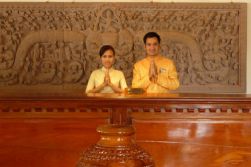
We are met on arrival and transferred to our hotel. Luang Prabang is a peaceful, provincial city and is the spiritual capital of Laos. There is little traffic on the roads, and monks in orange robes can be seen bustling about on their daily business.
Tonight features a special welcome dinner at L’Elephant Restaurant.
We suggest 03 options for accommodation:
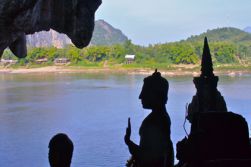
After breakfast, transfer to pier for a cruise up along the Mekong. Before cruising, start your morning a visit to the most photographed temple, Wat Xieng Thong. Located at the end of the peninsula, close to the Mekong, this temple was built in 1560 by King Setthathirat, the library was added in 1828.
Cruise up the Mekong River to the famous Pak Ou Caves. Locally called Tam Ting, the caves are filled with thousands of gold-lacquered Buddha statues. The statues range in size from a few centimeters tall to the height of a human and are crammed into the cave which is nestled in a limestone cliff. The caves are also a destination for local pilgrimages.
On the boat journey admire the several waterways that have traditionally been used as the local form of transportation. These waterways continue to be used in that manner today in many parts of the country and a local boat is probably one of the most rewarding ways to discover life along the rivers. As you cruise along, observe the daily activities of fishermen, how they throw their nets in with elegant arm gestures and rely on the water for their livelihood. For the villages settled along the Mekong, the river plays an important role in their daily life and usually represents the only means of transportation and commerce.
After visiting the caves cruise back to Luang Prabang. If time permits, stop on the way back at Ban Xang Hay, a village that specializes in making rice wine.
The city tour begins in the afternoon with your guide who will teach you more about the enchanting World Heritage Town of Luang Prabang. The tour starts at the former Royal Palace, now the National Museum. Continue to Wat Mai, a temple renowned for its golden bas-relief. Continue to the Traditional Arts & Ethnology Centre, a museum dedicated to exploring the rich diversity of Laos’ ethnic minorities. Traditional costumes, tools, and artifacts are on display alongside in-depth descriptions and written histories. It is a great opportunity to gain insight in to the Lao people (note: closed on Monday).
Tonight we enjoy dinner at Indochina Spirit restaurant with Lao Traditional dance show;
Overnight in Luang Prabang.
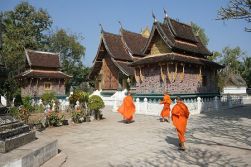
Worth getting up early in the holy city: early in the morning the monks move into your striking orange robes through the streets and are supplied by the citizens of rice and other food donations. Return to the hotel for breakfast.
After breakfast visit Wat Visoun, the holiest temple of the city, entirely rebuilt after being destroyed in 1887 by the invading Black Flags from Southern China. In the courtyard of Wat Visoun stands the Watermelon Stupa shaped like the fruit it takes its name from. You will continue by Wat Aham and then Wat That where the ashes of King Sisavang Vong are interred inside the large central stupa.
This afternoon you will be driven through the Luang Prabang countryside to Kuang Si Waterfalls (32km southwest of the city). Along the way you will drive through beautiful landscapes of rice fields, hills, and small villages. There are also viewpoints overlooking the Mekong River.
Stop en-route to visit a small village which is home to one of the area’s many ethnic minorities. You will have an opportunity to learn about their traditions and culture, much of which has remained unchanged for centuries. Upon reaching Kuang Si Waterfall, relax and enjoy the beautiful natural surroundings. The jungle and dense woods surrounding the falls is perfect for exploring on foot. For the adventurous, it is possible to walk to the top of the falls via a steep track where stunning views await you at the top.
Before you leave you might like to visit the bear sanctuary which is next to the falls, run by Free The Bears Fund Inc. There are currently 23 Asiatic Black Bears living in the sanctuary, which has saved them from poaching. The main threat to these bears is poaching due to the use of their bile in Chinese medicine. You can read about their habits and observe their playful nature, whilst learning about the difficulties they are facing.
On your return to Luang Prabang you can climb the 328 steps to the top of Mount Phousi. Enjoy a panoramic view of the city and the surrounding countryside as the sun sets. You may also like to explore the nearby evening hilltribe market, where you may find plenty of local souvenirs to buy such as handicrafts and textiles, before returning to your hotel. Overnight in Luang Prabang.
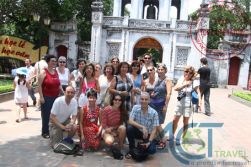
Today we fly to Hanoi. Originally named Thang Long or “City of the Ascending Dragon,” the city was first the capital of Vietnam in A.D. 1010. The city’s quiet air gives it a gracious, almost regal flavor. Hanoi is dotted with dozens of lakes around which you can usually find a cafe, a pagoda or two, shaded boulevards and attractive French style buildings.
We suggest 03 options for accommodation:
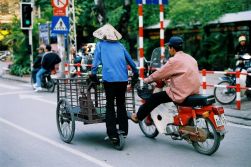
After breakfast we depart on a tour of the city, stopping at Ho Chi Minh’s residence, where he lived from 1954 until 1969. The wooden ethnic minority-style house, which was built on stilts, is surrounded by lovely peaceful gardens. In the same complex we will see the One Pillar Pagoda, founded by King Ly Thai To in 1049. This structure has become an important symbol for the people of Hanoi. We continue to the National Fine Arts Museum, located in colonial France’s former Ministry of Information, which has an eclectic mix of contemporary Vietnamese art, religious pieces, lacquerware and sculptures. Our next stop will be the Temple of Literature, Vietnam’s first university. Constructed in 1070, the gardens and well-preserved architecture offer a relaxing glimpse into Vietnam’s past.
After lunch at a local restaurant, we continue to Hoa Lo Prison (formerly known as the Hanoi Hilton during the American War). Our tour includes the Buddhist Tran Quoc Pagoda on West Lake and Quan Thanh Temple, dating from the Ly Dynasty. We’ll take in Vietnam’s diverse culture at the Museum of Ethnology, and take a cyclo ride through Hanoi’s Old Quarter, also known as “36 streets.” This bustling area of narrow streets and alleys is home to thousands of small businesses and shopkeepers. It is a great place to explore with plenty of photo opportunities all around you.
This evening we enjoy the famous water puppet show. This is a fantastic art form originated in northern Vietnam, and Hanoi is the best place to see it. Water puppetry is performed in a chest-deep pool of water, with the water’s surface as a stage. The puppeteers stand behind a curtained backdrop. First performed a thousand years ago on the surface of ponds and paddy fields in Vietnam’s Red River Delta, water puppetry (roi nuoc in Vietnamese) is the lively creation of farmers who spent their days in flooded rice fields.
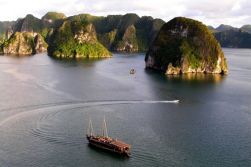
After breakfast, we travel from Hanoi to Halong bay where we ejoy a cruise in this marvelously scenic setting. We set sail while lunch is served, passing into the beautiful bay in the Gulf of Tonkin, where thousands of sculpted limestone islands rise from the waves like dragons’ teeth.
After lunch, we take a short trek to a nearby summit for a panoramic view of the bay dotted with golden sails, go swimming on a quiet beach or sunbathing on the sundeck. Later in the afternoon, we visit an interesting fishing village with the opportunity to interact with fishermen who have been living in the bay for almost three generations.
At sunset, you can kayak or take a bamboo rowboat to discover a water tunnel with many coral reefs in a scenic lagoon. Back on board, enjoy cocktails while watching the sunset. Have dinner and overnight on board.
We suggest 03 options for accommodation:
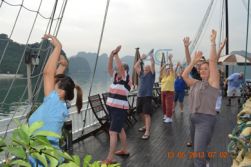
Greet the day with a morning Tai Chi exercise as the sun rises over the bay. After breakfast, we visit a beautiful limestone grotto, then back to the boat for a final glimpse of Halong Bay while cruising back to the dock. We drive back to Hanoi airport for our flight to Hue.
We suggest 03 options for accommodation:
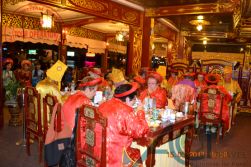
After breakfast, we embark on a boat trip on the Perfume River to theThien Mu Pagoda, the “Celestial Lady Pagoda” as it is called by the locals. Situated on the hill overlooking the river, the pagoda was built in 1601. Cruise on the river we soon reach the Imperial Tomb of Emperor Minh Mang, a majestic complex of courtyards, pavilions and temples in a beautiful natural setting, famous its architecture, military statues and elaborate decorations. We continue driving to explore the tombs of Emperors Tu Duc & Khai Dinh.
End the day again with a stroll through the bustling Dong Ba Market, which is famous for having the prettiest conical hats in the country. Observe the bustling local daily life in close range.
Tonight you will have a chance to enjoy “Royal dinner” at Royal Park restaurant. Enjoy a delicious food while listening to melodious music and having a feeling of being the King and Queen. All wear traditional royal clothes. All the served food is royal including dishes reminding dragon, phoenix, or peacock...Overnight in Hue.
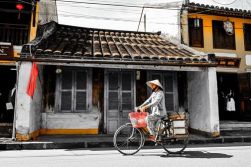
Breakfast at hotel. We will explore the Imperial Citadel. Modeled on Beijing’s Forbidden City, Hoang Thanh (Yellow Enclosure) and Tu Cam Thanh(Forbidden Purple City) are enclosed within the all-encompassing Kinh Thanh (the external enclosure).
We first approach to the striking Flag Tower at the entrance where a giant Vietnamese flag waves proudly. Then we enter the imposing Ngo Mon Gate, the main entrance of the Imperial Enclosure, by walking through the central passageway and its yellow doors, and the bridge that across the lotus pond, once reserved for the Emperor’s exclusive use. We then visit Thai Hoa Palace, the magnificently decorated reception hall with an ornate roof of huge timbers supported by 80 carved and lacquered columns. We will also visit the myriad Hall of the Mandarins, the Nine Dynastic Urns and the ruins of the Purple Forbidden City. Have your lunch at Tinh Gia Vien restaurant.
We transfer to Hoian town, climbing the dramatic Hai Van Pass, also called “the Pass of Ocean Clouds”. Enjoy the breathtaking scenery along the route. On the way to Hoian. We will visit famous Cham Museum, home to some 300 magnificent Cham sculptures dating to the 4th century. Next we visit the Marble Mountain, a cluster of five marble and limestone hills rising sharply from the surrounding rice fields.
Upon arrival Hoian. Check in hotel and free your time at leisure.
We suggest 03 options for accommodation:
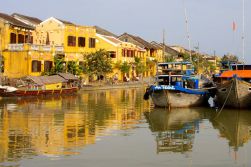
reakfast at hotel. Enjoy a walking tour, we will see the distinctive low tiled roof houses and the busy central market selling everything from vegetables, live stocks to daily household items. We will stroll along the Tran Phu Street to the Japanese Covered Bridge, constructed in 1593 by Japanese community to provide a link to the Chinese quarters across the stream. We also tour the family chapels, built by prominent merchants as centers for ancestor worship. We visit the private houses, many of which are occupied by the same family for up to eight generations. Enjoy the opportunity to interact with family members while inspecting the century old engraved panels of exquisite figures. We then visit assembly hall, and the Sa Huynh Museum, displaying artifacts from the early period of Hoi An’s history
Cruise down the Thu Bon River to visit a pottery and a woodcarving village. Enjoy interaction with locals – peasants, boat builders and craftsman before returning to the small Hoi An Harbor where colorfully painted boats are moored.
The remaining of the day is at leisure to rest.
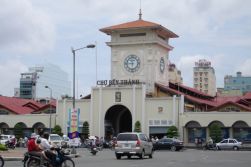
Breakfast at hotel. We transfer to the airport to take a short domestic flight to Ho Chi Minh city (Saigon). Upon arrival, you are welcome and transfer to your hotel for check in.
We start our visit with an overview drive round the city; passing the Opera House, and Dong Khoi Street, formerly known as the Rue Catinat during the French Years, now the main shopping avenue in the heart of the old colonial Saigon. Enjoy picture stops along the way - the red-brickCatholic Cathedral of Notre- Dame, the nearby 19th century Empire-style Post Office. We will tour the landmark: the Reunification Palace, formerly the Presidential Palace for the South Vietnamese government. Next we visit the harrowing War Remnants Museum, revealing the bloody fights by the Vietnamese against the French and Americans.
The interesting highlight of the day will be our exploration of the west of the city of District 5, the sprawling, densely packed Chinese neighborhood (Chinatown) called “Cholon”, meaning “big market”. Here we will explore Jade Emperor Pagoda, one of the oldest and the most interesting pagodas in the city. We end the day at the bustling Ben Thanh Market, where vendors display a vast array of goods and handicrafts, appealing to every taste.
We suggest 03 options for accommodation:
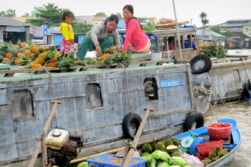
Breakfast at hotel. We’ll take a scenic early morning drive to Vinh Long (140 km), stop for photos at Tan An town over the flat rice fields. The program will start with the visit of Cai Be colorful floating marketcruising among local barges full of fruits and vegetables. Then, an optional stop can be made at local workshops where you can see how rice paste, coconut candy and pop-rice, pop-corn are made.
It’s so interesting to visit the handicraft village where you can see how they make some special products: making rice-net for spring-rolls, fish sauce & soya sauce, cooking salt, sewing coconut-leaves for cottage proof...
A mekong delta lunch will be served under the shade of local orchards on An Binh island with the famous dish “Fried Mekong Elephant Ear Fish”.
After lunch, the rowing boat will take you deeper into the countryside on smaller canals. It’s very interesting to see traditional houses made of wood and palm tree leaves and see some activities of the local farmers with some opportunities to interact with them and see how they catch fish or pick up fruits by ancestral ways in Mekong delta..
One more stop can be made at the nursery garden where you can learn how to have some high quality fruit trees. It’s the best choice for you to contact the real famous farmers - Mr Tiger & his son who are very successful in Vietnam agriculture. We will enjoy some kinds of fruits from his garden & homemade rice wine when listening to the traditional music. One more thing to do in this trip is biking. It will be so amazing to bike on village paths to see the local farms, houses, real life and the ancestral ways to pick up fruits in Mekong delta.
Drive back to Saigon. Free your time at leisure and overnight in Saigon.
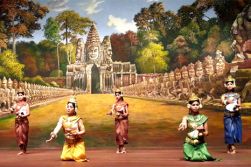
Breakfast at hotel. We transfer to the airport to take a flight to Siem Reap (Cambodia). Upon arrival, you are welcome and transfer to your hotel for check in.
We begin our exploration at the fortified royal city of Angkor Thom, built in 1,100, covering an area little less than 4 square miles. We enter the imposing South Gate after a causeway lined on both side by multiple statues of demons and gods, all carrying a giant naga (snake). We then continue to the Elephant Terrace, a base for the Kings’ grand audience hall and a site for public ceremonies. On both end of the retaining wall we can see the famous lines of elephants. Next to it is the Terrace of the Leper King, a platform with a nude statue, one of Angkor’s many unanswered mysteries. We also explore the ruined Baphuon, the Royal Enclosure and Phimeanakas - the “Celestial Palace”.
The most striking experience today will be a visit to the stunning Bayon Temple, one of the most popular and compelling sites in Angkor. Its exterior gallery walls contain some of the most extensive and best bas-reliefs, depicting everyday scenes with historical details of battles won and lost by the Khmers. Today at dusk, we will watch the sunset over the Cambodian countryside from the upper terraces of an ancient Angkorian Temple.
We suggest 03 options for accommodation:
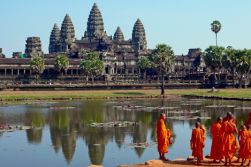
After breakfast, we devote the entire morning to Angkor Wat, the crowning jewel of Khmer architecture, the national symbol of Cambodia, and the optimum highlight of any visit to Southeast Asia. The largest, best preserved and most religiously significant of the Angkor temples, Angkor Wat impresses visitors with her sheer scale, beautifully proportioned layout, and the delicate artistry of its carvings. It is now one of UNESCO’s most famous World Culture Heritage Site, and is considered by art historians the definitive example of classical Khmer art and architecture.
In the afternoon we explore Ta Prohm, “Ancestor of Brahma”, also nicknamed “Kingdom of Trees”. Following an unusual archaeological decision, the jungle has been only partly cut back, so that the buildings are covered with the roots of huge banyan and kapok trees which rise high above the temple.
We will continue on to Banteay Srei - the “Citadel of Women” - a tiny enchanting temple built of red sandstone in the 10th century dedicated to the Hindu God Shiva. We have time to study closely the exquisitely carved male and female figures in the niches, all with beautiful style and proportion, representing the extraordinary skills and superior artistic appealing of the Khmer sculpture.
Transfer back to the city. Free your time at leisure.

This morning we continue our in-depth exploration of the magnificent Angkorian archeological ruins. Our first stop is Prasat Kravan, the Hindu temple built in 921 with five brick towers and spectacular bas- reliefs on the interior walls. Next we visit Banteay Kdei – a massive Buddhist temple dating back to 12th century, surrounded by four concentric walls, featuring towered enclosures and shoulder hugging corridors in a jungle setting.
We then visit the Tonle Sap Lake. Located in the heart of Cambodia, this huge lake swells up to seven times of its original size during the monsoon season every year. Its ecosystem is one of the richest and the most diversified in the region. We will explore Kampong Kleang, one of the most unspoiled floating communities on the lake by boat. We will cruise on the wooden sampan across the vast lake to the floating villages, passing submerged forests and fish farms. If the timing is right it might even be possible to visit a floating school to interact with teachers and students. Observe the authentic village life while we stroll by the simple huts.
Transfer back to the city. Free your time at leisure unstill our guide and driver pick you up and transfer to the airport to catch your departure flight.